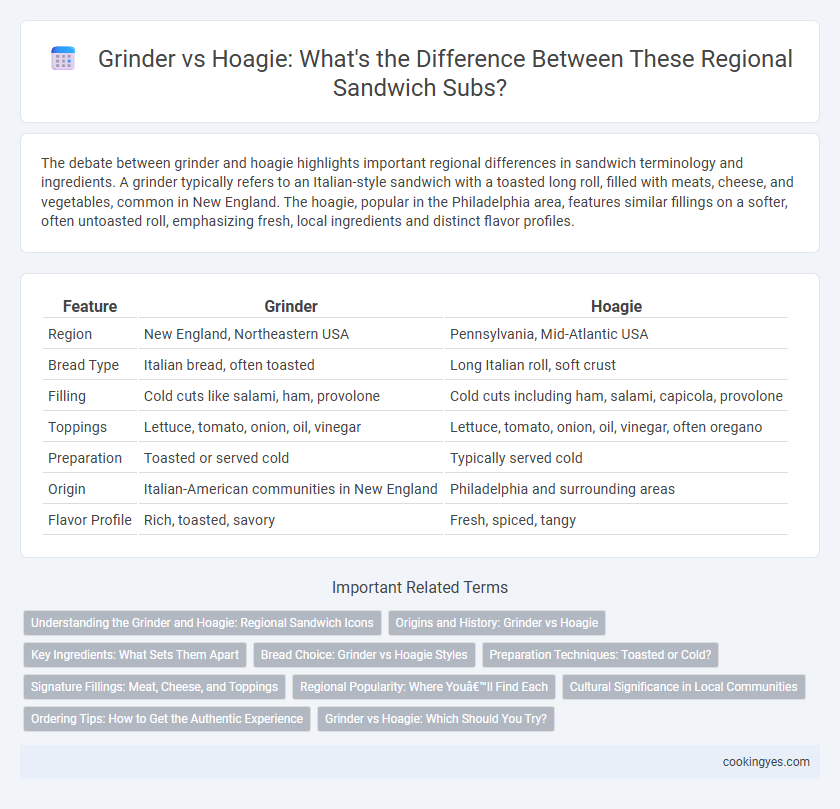The debate between grinder and hoagie highlights important regional differences in sandwich terminology and ingredients. A grinder typically refers to an Italian-style sandwich with a toasted long roll, filled with meats, cheese, and vegetables, common in New England. The hoagie, popular in the Philadelphia area, features similar fillings on a softer, often untoasted roll, emphasizing fresh, local ingredients and distinct flavor profiles.
Table of Comparison
| Feature | Grinder | Hoagie |
|---|---|---|
| Region | New England, Northeastern USA | Pennsylvania, Mid-Atlantic USA |
| Bread Type | Italian bread, often toasted | Long Italian roll, soft crust |
| Filling | Cold cuts like salami, ham, provolone | Cold cuts including ham, salami, capicola, provolone |
| Toppings | Lettuce, tomato, onion, oil, vinegar | Lettuce, tomato, onion, oil, vinegar, often oregano |
| Preparation | Toasted or served cold | Typically served cold |
| Origin | Italian-American communities in New England | Philadelphia and surrounding areas |
| Flavor Profile | Rich, toasted, savory | Fresh, spiced, tangy |
Understanding the Grinder and Hoagie: Regional Sandwich Icons
The grinder and hoagie are iconic regional sandwich variations primarily found in the Northeastern United States, each defined by unique bread types and fillings. Grinders typically feature a crusty Italian roll toasted or hot, stuffed with a mix of cold cuts, cheese, and often meatballs or sausage, originating from New England. Hoagies, rooted in Philadelphia, use a softer, elongated Italian roll loaded with deli meats, provolone cheese, lettuce, tomato, and onions, emphasizing fresh, cold ingredients for a distinct sub sandwich experience.
Origins and History: Grinder vs Hoagie
Grinders originated in New England during World War II, named after the Italian immigrant laborers, or "grinders," who worked hard and needed hearty sandwiches. Hoagies trace back to South Philadelphia in the early 20th century, emerging from Italian-American communities and inspired by the "hog island" workers. Both sandwiches share Italian roots but represent distinct regional identities shaped by their unique immigrant and labor histories.
Key Ingredients: What Sets Them Apart
Grinders traditionally feature Italian cold cuts such as salami, capicola, and mortadella layered with provolone cheese, lettuce, tomato, and onion on a thick, crusty Italian roll. Hoagies emphasize a combination of deli meats like ham, turkey, and roast beef, often accompanied by sharp provolone, shredded lettuce, sliced tomatoes, onions, and a drizzle of oil and vinegar on a long, soft sesame-seeded hoagie roll. The key ingredient distinction lies in the types of meats and bread texture, with grinders offering a denser, chewier experience, while hoagies deliver a lighter, tangier profile.
Bread Choice: Grinder vs Hoagie Styles
Grinder sandwiches feature crusty, dense Italian or French bread that offers a chewy texture and holds up well to hot fillings and robust ingredients. Hoagies use softer, slightly sweeter rolls with a tender crumb that complements cold cuts and fresh vegetables without overwhelming delicate flavors. The contrasting bread choices define the regional identity and influence the overall sandwich experience between grinders and hoagies.
Preparation Techniques: Toasted or Cold?
Grinders are typically toasted, enhancing the texture with a crispy crust and warm, melted fillings that blend flavors thoroughly. Hoagies are usually served cold, preserving the freshness of the deli meats, cheeses, and crisp vegetables, which emphasizes a lighter, firmer bite. The choice between toasted or cold preparation significantly influences the regional sandwich experience, catering to distinct taste preferences and textures.
Signature Fillings: Meat, Cheese, and Toppings
Grinders typically feature Italian cold cuts like capicola, salami, and provolone cheese, layered with lettuce, tomatoes, onions, and a splash of red wine vinegar or oil. Hoagies emphasize a mix of cured meats such as ham, genoa salami, and American cheese, complemented by shredded lettuce, tomatoes, onions, and a tangy Italian dressing. Both sandwiches highlight fresh, high-quality fillings but differ in regional seasoning and bread texture preferences.
Regional Popularity: Where You’ll Find Each
The grinder sandwich is predominantly popular in New England, especially Rhode Island and parts of Massachusetts, where it's often loaded with Italian cold cuts and melted cheese on a toasted long roll. In contrast, the hoagie is a staple of the Philadelphia region, featuring a crusty roll packed with meats, cheeses, and fresh vegetables, symbolizing the city's Italian-American heritage. These regional preferences highlight localized sandwich traditions shaped by immigrant influences and cultural tastes.
Cultural Significance in Local Communities
Grinders and hoagies represent more than just sandwich styles; they embody regional pride and cultural heritage in New England and Philadelphia respectively. The grinder is closely tied to Italian-American communities in Connecticut and Massachusetts, symbolizing local identity through its distinct crusty bread and hearty fillings. In contrast, the hoagie thrives in Philadelphia's working-class neighborhoods, serving as a culinary icon that reflects the city's diverse immigrant history and communal spirit.
Ordering Tips: How to Get the Authentic Experience
When ordering a grinder in New England, specify fresh Italian cold cuts and ask for the roll to be toasted, ensuring a crunchy texture with melted cheese. For an authentic Philadelphia hoagie, request Amoroso's roll filled with thinly sliced deli meats, crisp lettuce, tomatoes, onions, and a drizzle of oil and vinegar. Emphasize regional ingredients and preparation methods to capture the true flavor profiles unique to each sub style.
Grinder vs Hoagie: Which Should You Try?
Grinders and hoagies are both popular regional sub sandwiches, with grinders typically associated with New England and hoagies rooted in Philadelphia. Grinders feature crusty Italian bread filled with cold cuts or hot meats, often toasted or grilled to enhance flavors. Hoagies use soft, long rolls packed with deli meats, cheeses, and fresh vegetables, emphasizing a fresh, cold preparation that highlights quality ingredients.
Grinder vs Hoagie for regional sandwich sub Infographic

 cookingyes.com
cookingyes.com